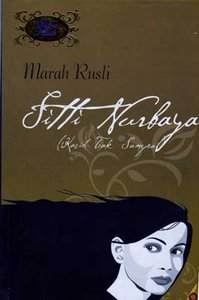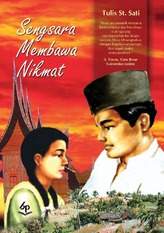
Mochtar Lubis was an Indonesian Batak journalist and novelist who co-founded Indonesia Raya and monthly literary magazine "Horison". His novel Senja di Jakarta was the first Indonesian novel to be translated into English. He was a critic of Sukarno and was imprisoned by him.

Pertemuan Jodoh is an Indonesian novel by Abdul Muis originally published in 1932. It tells the story of two students who are driven apart by their class differences, but eventually marry.

Jalan Tak Ada Ujung is an Indonesian novel by Mochtar Lubis first published by Balai Pustaka in 1952. It takes place during the Indonesian war of independence and tells the story of Guru Isa, a schoolteacher who assists the guerrilla freedom fighters yet lives in fear.

Senja di Jakarta is an Indonesian novel written by Mochtar Lubis and first published in English by Hutchinson & Co. in 1963, with a translation by Claire Holt. It was later published in Indonesian in 1970.

Azab dan Sengsara is a 1920 novel written by Merari Siregar and published by Balai Pustaka, Indonesia's major publisher at that time. It tells the story of two lovers, Amiruddin and Mariamin, who are unable to marry and eventually become miserable. It is generally considered the first modern Indonesian novel.

Sitti Nurbaya: Kasih Tak Sampai is an Indonesian novel by Marah Rusli. It was published by Balai Pustaka, the state-owned publisher and literary bureau of the Dutch East Indies, in 1922. The author was influenced by the cultures of the west Sumatran Minangkabau and the Dutch colonials, who had controlled Indonesia in various forms since the 17th century. Another influence may have been a negative experience within the author's family; after he had chosen a Sundanese woman to be his wife, Rusli's family brought him back to Padang and forced him to marry a Minangkabau woman chosen for him.

Sengsara Membawa Nikmat is an Indonesian novel written by Tulis Sutan Sati. It was published in 1929 by Balai Pustaka. It tells the story of Midun, the son of a farmer, who experiences many trials before finally living happily with his new wife. It has been noted as one of Sati's most interesting works.

Layar Terkembang is an Indonesian novel by Sutan Takdir Alisjahbana. Published in 1936 or 1937 by Balai Pustaka, it tells the story of two sisters and their relationship with a medical student. It has been noted as emphasizing the need for Indonesians to adopt Western values in order to modernize the country.
Darah Muda is a 1927 novel written by Indonesian writer Djamaluddin Adinegoro and published by Balai Pustaka. It is one of few Indonesian novels from the period in which the protagonists succeed in love.

Dian jang Ta' Koendjoeng Padam is a 1932 novel by Sutan Takdir Alisjahbana. It was published by Balai Pustaka.
Asmara Djaja is a 1928 novel written by Indonesian writer Djamaluddin Adinegoro and published by Balai Pustaka. It is one of few Indonesian novels from the period in which the protagonists succeed in love.

Di Bawah Lindungan Ka'bah is the 1938 debut novel of the Indonesian author Haji Abdul Malik Karim Amrullah (1908–1981). Written while the author worked in Medan as the editor of an Islamic weekly magazine, the novel follows the doomed romance of a young Minang couple from different social backgrounds. Generally praised for its simple yet eloquent diction, the novel has been twice adapted into film, first in 1977 and then in 2011.

Tenggelamnja Kapal van der Wijck is an Indonesian serial and later novel by Haji Abdul Malik Karim Amrullah published in 1938. It follows the failed love between Zainuddin, a mixed-race man, and Hayati, a pure Minang woman.

Atheis is a 1974 Indonesian film directed by Sjumandjaja and adapted from Achdiat Karta Mihardja's novel of the same name. It follows a young Muslim man named Hasan who, through his interactions with others, loses his faith.

Kubah is an Indonesian novel written by Ahmad Tohari. It follows a poor man named Karman who becomes a member of the Indonesian Communist Party, only to find himself a victim of the ongoing political struggles in 1950s Indonesia. After the Party's destruction he spends twelve years as a prisoner at Buru before returning to his hometown and becoming a devout Muslim.

Kalau Ta' Oentoeng is a 1933 novel written by Sariamin Ismail under the pseudonym Selasih. It was the first Indonesian novel written by a woman. Written in a flowing style heavily dependent on letters, the novel tells the story of two childhood friends who fall in love but cannot be together. It was reportedly based on the author's own experiences. Although readings have generally focused on the novel's depiction of an "inexorable fate", feminist and postcolonial analyses have also been done.

Anak Perawan di Sarang Penjamun is a 1962 Indonesian film directed and produced by Usmar Ismail for PERFINI. Starring Bambang Hermanto and Nurbani Yusuf, it follows a young woman who is kidnapped by a group of bandits, only to fall in love with their leader. The film, adapted from the 1940 novel of the same name by Sutan Takdir Alisjahbana, was repeatedly blacklisted by the Indonesian government and only saw release several years after production ended.
Noesa Penida is a 1941 film from the Dutch East Indies which was directed by Andjar Asmara and produced by The Teng Chun of Java Industrial Film. It tells of a love triangle between two brothers, born to a commoner, and a noble woman.

Korrie Layun Rampan was an Indonesian novelist, short story writer, poet, literary critic, journalist, and politician.

Soeman Hasibuan better known by his pen name Soeman Hs, was an Indonesian author recognized for pioneering detective fiction and short story writing in the country's literature. Born in Bengkalis, Riau, Dutch East Indies, to a family of farmers, Soeman studied to become a teacher and, under the author Mohammad Kasim, a writer. He began working as a Malay-language teacher after completing normal school in 1923, first in Siak Sri Indrapura, Aceh, then in Pasir Pengaraian, Rokan Hulu, Riau. Around this time he began writing, publishing his first novel, Kasih Tak Terlarai, in 1929. In twelve years he published five novels, one short story collection, and thirty-five short stories and poems.
















